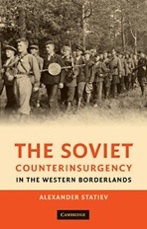 Alexander Statiev is a Canadian assistant prof at the University of Waterloo, and he’s just produced the first broad study in English of anti-Soviet partisans in the postwar period.
Alexander Statiev is a Canadian assistant prof at the University of Waterloo, and he’s just produced the first broad study in English of anti-Soviet partisans in the postwar period.
He’s used Soviet archives, newly available, to study the methods of counterinsurgency in the long stretch of territory from Latvia in the North to Moldova in the South that was annexed by the Soviets by mid 1940, lost for a while to Germans, and regained in 1944.
He has also used partisan memoirs and local materials in a labour of research that is quite astonishing and briliant. Most of those interested in the insurgents (a term I’m slightly uncomfortable with because it makes them sound like “rebels”), the “Forest Brothers” tended to be those from the particular countries involved. Part of the value of this book is its study of the region as a whole.
Statiev makes some well-known points. The Soviets faced resistance wherever they annexed lands and in some places they could not control the countryside for years after the annexation. When the Soviets first arrived, locals discovered their standards of living fell and the new regime was extremely authoritarian, to put it mildly. Tens of thousands were deported in terrible conditions.
Statiev adds that lives lost in resistance equal roughly as many as all the lives lost by Americans in the European theatre of World War 2, and I assume he is counting only deaths by immediate violence, not the losses by slow death in the gulag.
The Soviets launched populist reforms in these newly annexed lands in an attempt to exploit class divisions, but these techniques did not work well in the countryside, where the vast majority of resisters came from.
Furthermore, Soviet repression was not aimed necessarily at resisters, but to whole blocks of the population. For example, those labeled as “kulaks” had no choice but to fight or be deported. Indeed, the Soviet regime used mass deportations as a tool of security policy. Peasants, one cannot stress enugh, constituted the majority of the guerillas.
The resistance lost steam over a number of years as the struggle became futile.
Somewhat less known and less comforting to those who support the memory of the resisters are some of the darker facts of their history: partisans fought primarily against their own people, those who were willing to accept the new regime. The partisans looked upon them as collaborators.
The whole issue of collaboration is fraught – it only applies to working with regimes that lose. What I mean is collaborators in our understanding tend to have been working with Nazis. What do we call those who worked with the Soviets, in particular the early adopters of their system?
The discussion leads to a nightmare of sorts, one that is still playing out in our discussion of Eastern Europe. Again, I wish there were parallel narratives instead of competing ones as I have mentioned repeatedly in these posts.
Still, one must admit that many of the many of the partisan acts were extremely brutal and unscrupulous. For an example of such brutality, see Donatas Glodenis’s post on this very issue (in Lithuanian)
So what’s it all mean?
Simple stories rarely hold together over time. I still believe the resistance was heroic, but there were crimes nested within crimes in the resistance and the counterinsurgency. The very fact of the resistance demonstrated that the annexation was carried out by force. Had there been no resistance then, arguably, there would be no independence now.